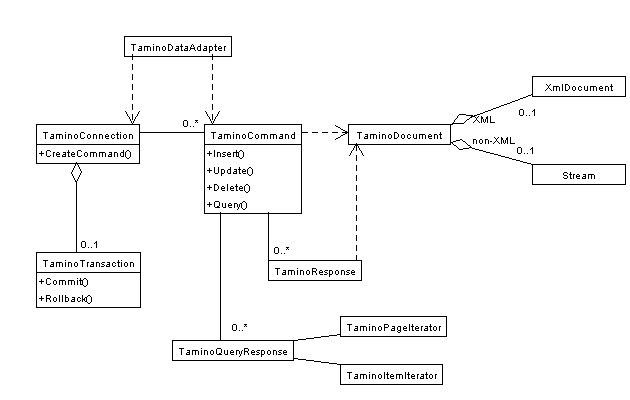The following graphic shows a high-level UML class diagram of the Tamino API for .NET:

The most frequently used API classes include the following:
TaminoConnectionRepresents a connection to a Tamino database. A connection is
necessary in order to be able to create TaminoCommands
so that the application can perform operations on the Tamino
database.
TaminoCommandProvides basic Tamino database commands. The class can handle XML data as well as non-XML (binary) data.
TaminoResponseRepresents information that Tamino returns in response to a command invocation.
TaminoQueryResponseRepresents information that Tamino returns in response to a query command invocation. Methods are provided to permit iteration over the result set.
TaminoPageIteratorProvides page-by-page iteration over the result set of a Tamino query.
TaminoItemIteratorProvides item-by-item iteration, either over the whole result set of a Tamino query or over a single page of the result set.
TaminoTransactionRepresents a Tamino database transaction.
TaminoDataAdapterProvides support for filling a dataset from Tamino and writing changes made to the dataset back to Tamino.
The basic API classes allow you to use the full power of XML support in
the .NET Framework. Programming using TaminoDataAdapter
and datasets is useful for Rapid Application Development (RAD) and simple XML
data.
The following example illustrates a very simple program:
// create connection
TaminoConnection = new TaminoConnection("http://localhost/tamino/mydb");
// open connection
connection.Open(TaminoConnectionMode.AutoCommit);
// create command
TaminoCommand command = connection.CreateCommand("mycollection");
// do simple insert
TaminoResponse response = command.Insert(new TaminoDocument(xmlDoc));
Trace.Assert(response.ReturnValue == "0", response.ErrorText);
// close connection
connection.Close();
Note:
A large set of samples is
provided as part of the installation. They demonstrate various facets of using
the Tamino API for .NET.